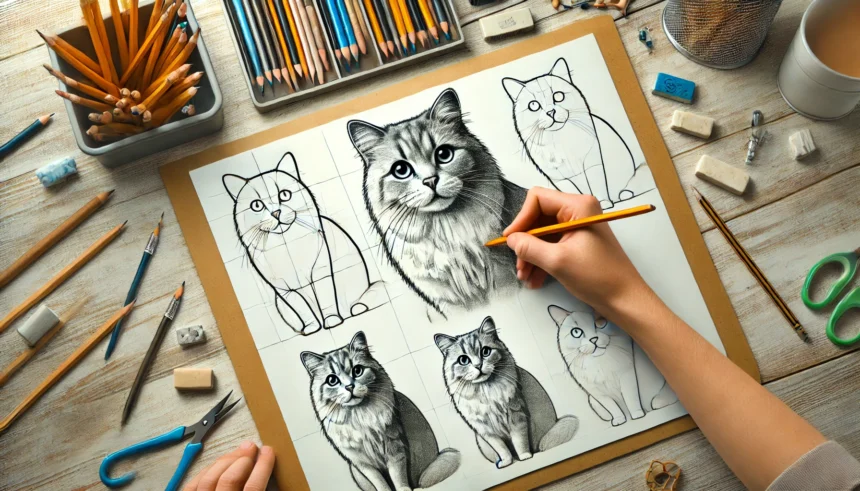The drawing:a4z_-ymtkr8= cat technique is an intriguing and structured approach for creating realistic, detailed cat illustrations. It’s a method that combines traditional drawing foundations with innovative techniques, allowing artists to craft lifelike portrayals of cats that captivate the viewer. Whether you’re a beginner just learning the basics of feline anatomy or a seasoned artist looking for a fresh challenge, this method offers a detailed process that refines your skills and sharpens your artistic instincts.
At its core, the drawing:a4z_-ymtkr8= cat method focuses on breaking down complex images into more manageable shapes, making it easier to capture the proportions and subtleties of a cat’s body. The emphasis is placed on mastering the fine details, such as the texture of the fur, the glint in the eyes, or the graceful arch of a cat’s body as it stretches or rests. With practice, this technique can dramatically improve your ability to portray cats in a way that feels both dynamic and natural, perfect for both sketchbook enthusiasts and digital artists alike.
Understanding the drawing:a4z_-ymtkr8= cat Technique
The drawing:a4z_-ymtkr8= cat technique is built on a structured, step-by-step approach that helps artists create accurate and dynamic representations of cats. This method starts by simplifying the cat’s form into basic geometric shapes—circles, ovals, and triangles—which serve as the foundation for the final drawing. For instance, the head can begin as a circle, with smaller circles marking where the eyes will go. By mapping out these proportions early on, artists can ensure that their drawings remain balanced and symmetrical as they progress. The drawing:a4z_-ymtkr8= cat technique emphasizes precision in these early stages, allowing for more fluid and natural lines as the drawing develops.
Once the basic structure is in place, the next step is to refine these shapes by adding details, such as the fur texture, whiskers, and the delicate features of the eyes, nose, and mouth. This is where the real artistry comes in—mastering the ability to bring a drawing to life through subtle shading, highlights, and attention to texture. The drawing:a4z_-ymtkr8= cat method encourages artists to focus on capturing the unique characteristics of each cat, such as the pattern of its fur or the expression in its eyes, creating a portrait that feels full of life and personality.
Why the drawing:a4z_-ymtkr8= cat Method is Popular Among Artists
The drawing:a4z_-ymtkr8= cat method has gained popularity among artists for its versatility and accessibility. Unlike some drawing techniques that require years of formal training or advanced tools, this method is designed to be approachable for artists at any skill level. Beginners can benefit from its simple, structured approach, while more experienced artists appreciate the way it allows for creative freedom and expression within a reliable framework. The step-by-step nature of the drawing cat technique makes it easy to learn while providing plenty of room for experimentation and personal style.
Another reason for its popularity is the sheer enjoyment artists derive from using this method. Drawing cats can be both challenging and rewarding, and the drawing:a4z_-ymtkr8= cat technique offers a way to tackle the challenge with confidence. Artists find that by following the structured steps, they can focus more on the fun and creative aspects of drawing without worrying about technical missteps. The process encourages artistic growth, allowing users to experiment with different poses, perspectives, and styles, while still producing accurate and engaging drawings.
Step-by-Step Guide
To start a drawing:a4z_-ymtkr8= cat illustration, begin by sketching the basic shapes that represent the cat’s anatomy. The head can be drawn as a circle, and the body as an elongated oval. These foundational shapes help establish the proportions, ensuring the head isn’t too large for the body or the legs too short. Next, place guidelines within these shapes to indicate the positioning of key features like the eyes, ears, and tail. This step is crucial in the drawing cat method, as it helps keep the drawing balanced and proportional as you add more details.
Once the basic structure is in place, begin refining the drawing by adding the contour lines that define the cat’s unique features. Focus on the shape of the eyes, ears, and the flow of the body as it transitions into the legs and tail. The drawing:a4z_-ymtkr8= cat technique emphasizes attention to detail, particularly in the fur and the texture. Use short, controlled strokes to mimic the direction and flow of the fur. At this stage, adding shading to key areas, such as around the eyes, under the chin, and along the back, will help to create depth and dimension, bringing your drawing to life.
Tips for Perfecting the Cat Drawing
To perfect your drawing:a4z_-ymtkr8= cat, it’s essential to practice observing real cats or reference images. Pay attention to how light interacts with their fur, the way their muscles move beneath their skin, and the subtle differences in body language between different poses. Observation is a key component of this drawing technique because it allows you to bring more realism and personality into your work. Practicing quick sketches of cats in various poses will help you develop your ability to capture their fluid movements and natural grace, which is essential for mastering the drawing cat method.
Additionally, experimenting with different tools can enhance your drawing:a4z_-ymtkr8= cat illustrations. For instance, using a combination of hard and soft pencils will allow you to create a greater range of textures, from the soft, fluffy fur of a kitten to the sleek coat of a short-haired cat. Digital tools also offer a lot of flexibility, as you can layer colors and textures with ease. Don’t be afraid to experiment with new techniques, as this is how you’ll find your own unique style within the drawing cat framework.
Common Mistakes to Avoid in Cat Drawings
When working with the drawing:a4z_-ymtkr8= cat technique, one common mistake is neglecting proportions. It can be easy to get caught up in the details and forget to check that the basic shapes and structure are correct. Always take a moment to step back and assess whether the proportions of the head, body, and legs are balanced. This is particularly important in the drawing cat method because the initial shapes guide the entire drawing. If they are off, the finished product can look unnatural.
Another frequent issue is over-shading or adding too much texture too early. In the drawing:a4z_-ymtkr8= cat method, it’s best to start with light, gradual shading, building up texture as you go. Adding too much detail too soon can make the drawing look heavy and overworked. Patience is key; take your time to layer in shadows and fur texture bit by bit to achieve a more natural, lifelike result. This careful approach ensures that your drawing cat will have depth without losing its lightness and fluidity.
Tools and Resources to Enhance Your Cat Art
For artists practicing the drawing:a4z_-ymtkr8= cat technique, having the right tools can make a significant difference. A high-quality set of pencils, ranging from 2H to 6B, provides versatility in creating both fine lines and deep shadows. Blending stumps and kneaded erasers are also essential for smoothing out pencil strokes and achieving a polished look. Additionally, many artists using the drawing cat method have found that digital drawing tablets, such as the Wacom or iPad Pro with Apple Pencil, offer flexibility in adjusting textures, layers, and colors in a seamless way.
Beyond tools, accessing the right resources is equally important. Online platforms like YouTube and art courses on Udemy or Skillshare offer tutorials specifically focused on cat anatomy and the drawing:a4z_-ymtkr8= cat method. These resources can provide you with additional tips, tricks, and techniques that can elevate your artwork. Engaging with art communities, whether through social media or local groups, also provides feedback and inspiration, helping you refine your skills with the drawing cat technique.
Read More: Halo (2003) game icons banners
Conclusion
In conclusion, mastering the drawing:a4z_-ymtkr8= cat method can be a rewarding experience for artists of all skill levels. Its structured approach provides a strong foundation while allowing for creative expression and experimentation. By practicing regularly, focusing on observation, and using the right tools and techniques, you can create stunning, lifelike drawings of cats that showcase both technical skill and artistic flair. Whether you’re just starting out or looking to refine your skills, the drawing:a4z_-ymtkr8= cat technique offers a comprehensive path to improvement and artistic satisfaction.





